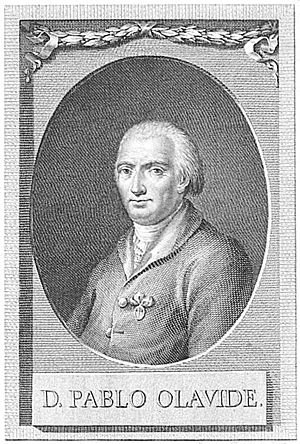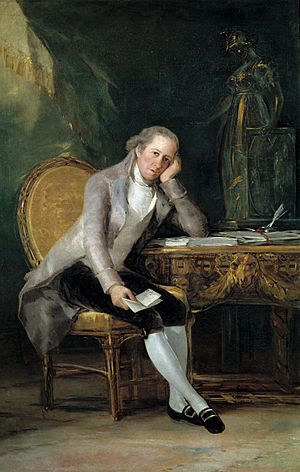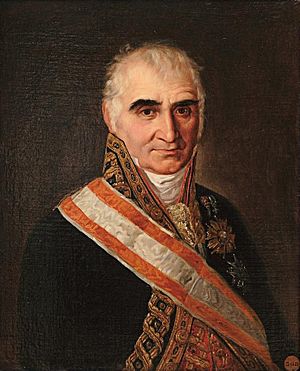Spanish confiscation facts for kids
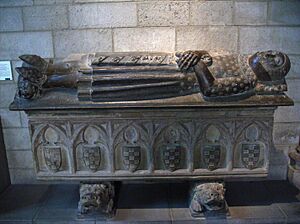
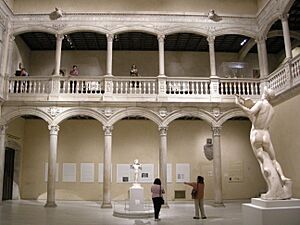
The Spanish confiscation was when the Spanish government took and sold property, including land from the Catholic Church. This happened from the late 1700s to the early 1900s. It was a long process that started in 1798 and ended in 1924.
Confiscation meant the government took land and buildings from "mortmains." These were mainly the Catholic Church and religious groups. They had gathered a lot of property over time. Towns also owned land that was taken. The government then sold these properties, often through public sales. Other countries, like Mexico, had similar events.
The main reason for this in Spain was to get money. The government needed to pay off its huge debts. These debts were from special papers called vales reales. The government also wanted to make Spain richer. They hoped to create a middle class of farmers who owned their land. They also wanted to help capitalism grow, which meant more private ownership and a stronger money system. This would allow the state to collect more taxes. Confiscation was a key way that Spanish liberals changed how land was owned in the 1800s.
Contents
Confiscation Before the 1800s
Ideas from Olavide and Jovellanos
Many people thought Spanish farming was struggling because of "mortmain" property. These were lands owned by the Church and towns that could not be sold. This meant they were often not used well. They also could not be taxed. In 1787, José Moñino, a minister for King Charles III, said these lands caused "major damages."
Two thinkers, Pablo de Olavide and Gaspar Melchor de Jovellanos, suggested selling unused town lands. These lands were often empty and used for animals to graze.
Olavide believed that protecting livestock too much hurt farming. He said "all the lands should be put to work." He wanted to sell unused town lands mostly to rich people. They had the money to farm the land. A smaller part would go to farmers with two pairs of oxen. The money from these sales would start a savings bank. This bank would fund public works like roads and bridges.
Jovellanos had a stronger idea. He wanted to sell "council lands," which included town properties that earned tax money. He was a big supporter of economic liberalism. He believed these properties should be sold freely to anyone. He did not worry if a few rich people bought all the land. He thought freeing up these lands was good in itself. Jovellanos's ideas were spread widely in his 1795 book, Report on Agrarian Law. His ideas influenced the liberals who started the big confiscations in the 1800s much more than Olavide's.
Olavide and Jovellanos did not want to take Church property. But they did suggest limiting how much more land the Church could get. The Church and most of the Royal Council rejected this idea in 1766. Two books supporting this idea were even banned by the Spanish Inquisition.
King Charles III's Efforts
In 1766, to calm down riots, a local official in Badajoz ordered city property to be rented to "needy neighbors." Poor workers who could farm the land got first choice. King Charles III's new minister, the 10th Count of Aranda, spread this idea. It went to all of Extremadura in 1766 and the whole kingdom in 1767. An order in 1768 said this was to help the poorest farmers. But the plan was stopped in 1770.
This was not a true confiscation because the land was rented, not sold. It still belonged to the towns. The new rule in 1770 gave priority to farmers with more tools. This changed the original goal of helping the poor. Many poor farmers could not farm the land well or pay the rent. This was because they did not get loans to help them.
Olavide had criticized the first plan. He thought the poor farmers could not use the land fully. Later, he led projects in Andalusia where settlers got money to start farming. They also did not have to pay taxes at first.
Historians say King Charles III's actions were more about economics. He wanted to farm unused land. He was less focused on social reform. But his actions were part of a bigger plan to improve Spain's farming economy.
Godoy's Confiscation
During the rule of King Charles IV, a confiscation started in 1798. It was led by Mariano Luis de Urquijo and Miguel Cayetano Soler. King Charles IV got permission from the Vatican to take land from the Jesuits and other religious groups. This included hospitals and colleges. In total, about one-sixth of the Church's property was taken.
Historians see this as a key moment. It linked confiscation to solving public debt problems. King Charles III had seen it more as a way to reform farming. The later liberal confiscations in the 1800s followed Godoy's approach.
Confiscation in the 1800s
Joseph Bonaparte's Rule (1808–13)
On August 18, 1809, Joseph Bonaparte ordered that all religious orders be removed. Their property would then belong to the nation. Many religious groups were shut down this way.
Bonaparte also ordered a smaller confiscation. This did not take property itself. Instead, it took the money earned from property. This money went to support French soldiers in the Napoleonic Wars. This confiscation ended in 1814.
Cortes of Cádiz (1810–14)
In March 1811, the leaders of the Cortes of Cádiz (Spain's national assembly) faced a huge debt. This debt came from the vales reales from King Charles IV's time. The acting treasury secretary, José Canga Argüelles, said the debt was 7 billion reales. The Cortes of Cádiz decided to take certain properties from the "mortmains." These would then be sold. Two-thirds of the sale money would pay off national debt papers. This included the old vales reales and new "notes of liquidated credit." These new notes were used to pay for the War of Spanish Independence. The rest of the money would pay interest and the main debt.
A rule on January 4, 1813, called for taking all unused town lands. This was to help citizens who did not own land. It was also a reward for soldiers who fought for Spain. To meet three goals at once – money, patriotism, and social help – the property was split in half. One half would be sold to pay the national debt. The other half would be given as land plots. Soldiers got them for free. Landless citizens could get them for a fee. If they did not pay the fee, they lost the land. This made the social goal harder to achieve.
A rule on September 13, 1813, called these properties "national goods." The targets included supporters of Manuel Godoy and the French. It also included lands from four Spanish military orders. Convents and monasteries destroyed in the war were also included. Crown farms, except those for the king, were taken. Half of the unused town lands were also taken. This rule was never fully carried out. This was because King Ferdinand VII returned and brought back absolute rule. But it set up the legal ideas for later confiscations.
Trienio Liberal (1820–23)
In 1820, the Constitution of 1812 was brought back. The Trienio Liberal government again faced the national debt problem. On August 9, 1820, the new courts approved the Cortes of Cádiz's rule from 1813. But they added properties from the Spanish Inquisition to the list. This new rule valued the vales reales at their full original price. This was much higher than their market price.
Because the market price of debt papers was so low, buyers paid much less cash than the land's value. Sometimes it was less than 15 percent of the full price. In 1823, some leaders wanted to stop the confiscation. They wanted to give ownership to the people renting the land. One leader said that rich people were buying the farms. Then they would raise the rent for poor farmers. But the confiscation continued.
On November 8, 1820, a new rule brought back the Cortes of Cádiz's plan to sell unused lands from towns. A rule on October 1, 1820, also included Church confiscation. This was something the Cortes of Cádiz had not done. This rule affected monasteries and convents. Their goods and properties became "national assets" to be taken right away. A few days later, on October 11, 1820, a law stopped religious groups from buying more land.
Mendizábal's Confiscation (1836–37)
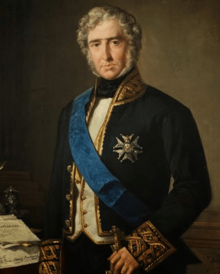
Juan Álvarez Mendizábal (prime minister for Queen Regent Maria Christina) and Pascual Madoz (finance minister for Queen Isabel II) led the two most important liberal confiscations. The 1836 Ecclesiastical Confiscation of Mendizábal had a huge impact on Spain's history.
Local committees were in charge of dividing the land. They often made very large plots. Only very rich people could afford these. Small farmers could not compete. Nobles and rich city people bought the land. This stopped a true middle class from growing in Spain.
This confiscation only applied to certain clergy members. The Church decided to excommunicate both the sellers and buyers of the land. So, most people bought land through others, not directly.
Espartero's Confiscation (1841)
On September 2, 1841, the new regent, Baldomero Espartero, ordered the confiscation of Church and religious group properties. This law was stopped three years later.
In 1845, the government tried to improve relations with the Church. This led to the signing of the Concordat of 1851.
Madoz's Confiscation (1855)
During the bienio progresista period, led by Espartero and Leopoldo O'Donnell, Finance Minister Madoz started a new confiscation. This one was managed better than Mendizábal's. The order was published on May 3, 1855. It included lands and taxes from the state, the clergy, and military orders. It also included properties from religious groups and towns. Religious schools and hospitals were not included. They helped reduce government spending.
Confiscation had caused arguments between conservatives and liberals for a long time. But eventually, all political groups agreed that unused assets needed to be put to use. This was to help Spain's economy grow. The Madoz law was stopped on October 14, 1856. But it started again two years later, on October 2, 1858. Changes in government did not stop the sales. They continued until the end of the century.
Historians often focus on Mendizábal's Confiscation. But Madoz's Confiscation involved many more sales. By 1867, almost 200,000 rural properties and over 27,000 city properties were sold. The state collected a huge amount of money between 1855 and 1895. This was almost twice what Mendizábal's Confiscation brought in. The money mostly went to cover the government's budget, pay off debt, and fund public works. Some money was set aside to fix churches.
The Madoz law is sometimes called a civil confiscation. But this is not quite right. Many common lands belonging to people were sold. But even more properties sold had belonged to the Church. The confiscation of farms belonging to rural Spaniards hurt millions. They had to move to cities or other countries to find work. It is thought that 35% of the properties sold belonged to the Church. 15% belonged to charities, and 50% to towns.
The Municipal Statute of 1924 stopped confiscation laws. This ended the Confiscation of Madoz.
What Happened After Confiscation?
Social Changes
At the time of the confiscations, Spain had two main areas. The south had very large farms. The north had small and medium-sized farms. Historians say the confiscations changed these areas differently. Small plots were usually bought by people from nearby villages. Larger plots were bought by rich people from cities, often far away. In the south, few small farmers could afford the large estates. This made the problem of landlordism even worse there. But this did not happen as much in the north.
Another big change was that shared town properties became private. Many farmers lost resources they needed to live. These included firewood and pastures. This caused many people from the countryside to move to cities or to the Americas. This movement was biggest in the late 1800s and early 1900s.
Religious Changes
The confiscations also forced thousands of religious people to leave their convents and monasteries. A royal order in 1835 closed convents with fewer than twelve members. In 1836, almost all monasteries were closed. In 1837, most female convents were closed too.
Historians note the sad situation of older priests who were forced out. They often lived in poverty, teaching Latin or doing odd jobs. So, closing religious orders had a huge impact on Spanish society. One liberal leader wrote in 1837 that closing religious orders was "the most gigantic step Spain has taken." He called it "the real act of reform and revolution."
The confiscations also changed how Spanish cities looked. They became less religious. For example, the governor of Madrid tore down 17 convents there.
Economic Changes
The confiscations brought in more than 14 trillion reales from sales. This greatly improved the government's money situation. They also made Spain's farms more productive. More land was farmed, and crops became more specialized. This was thanks to new investments by landowners. For example, olive and wine production grew a lot in Andalusia. But these gains also led to deforestation.
Most ordinary Spaniards suffered because of the harm done to the subsistence economy. This happened when shared lands, used for grazing animals, became private.
Cultural Changes
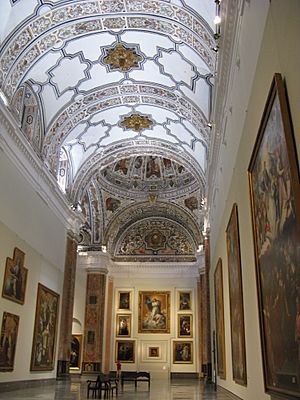
Many paintings and monastery libraries were sold cheaply. Some were sent to other countries. But many books also went to public libraries or universities. Others ended up in private hands and were lost.
The confiscations left many beautiful buildings, like churches and monasteries, in ruins. But others, like the Church of San Martín in Cuéllar, were saved. They became museums or other public buildings.
Political Changes
One goal of the 1800s confiscations was to make the liberal government stronger. In the north, people who bought properties formed a new group of small and medium landowners. They supported the government. But in southern Spain, large landowners bought most of the confiscated lands. This made it harder to achieve the goal of a stronger liberal regime.
About half of the lands taken had belonged to peasants and rural people. These shared lands supported their simple way of life. Taking them away destroyed their way of living and self-governance.
Environmental Changes
Because of the confiscations, millions of acres of forest became private property. These forests were cut down and plowed. This caused huge environmental damage that is still seen today. The cost of planting new trees, which has been going on for 70 years, is much more than the money made from the sales.
The confiscations of the 1800s were one of the biggest environmental disasters for the Iberian Peninsula in centuries. Madoz's Confiscation, especially, led to huge areas of public forest becoming private. The rich people who bought the land often paid with wood from it. Much of the deforestation in Spain happened at that time. This led to many plant and animal species disappearing.
Other Changes
Closing convents helped modernize Spanish cities. They changed from cities full of religious buildings to cities with taller buildings and new public spaces. Many former convents became public buildings. These included museums, hospitals, offices, and army barracks. Others were torn down to make way for streets, squares, and even parking garages. Some became churches again, or were sold to private owners.
Many old landmarks, especially in Castile and Madrid, were torn down during or because of the liberal confiscations.
See also
 In Spanish: Desamortización española para niños
In Spanish: Desamortización española para niños


